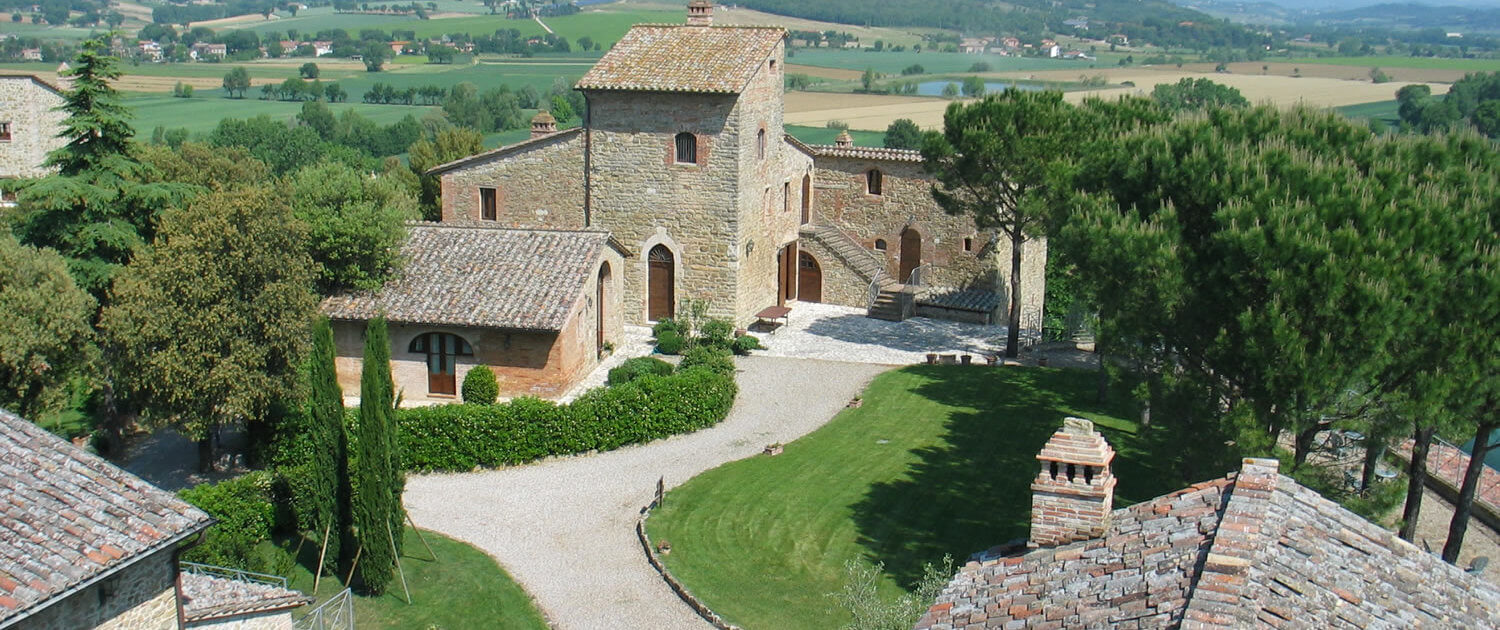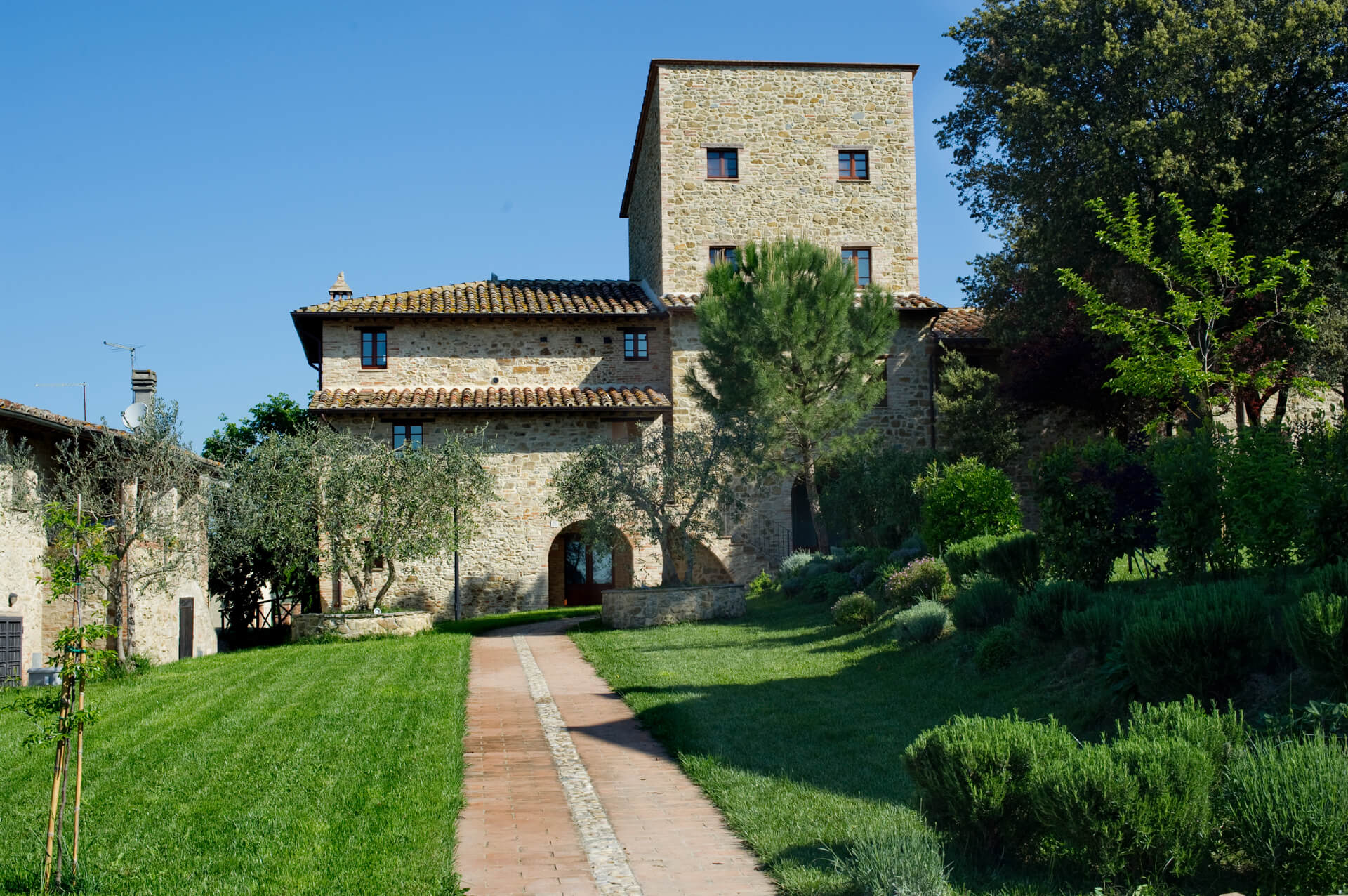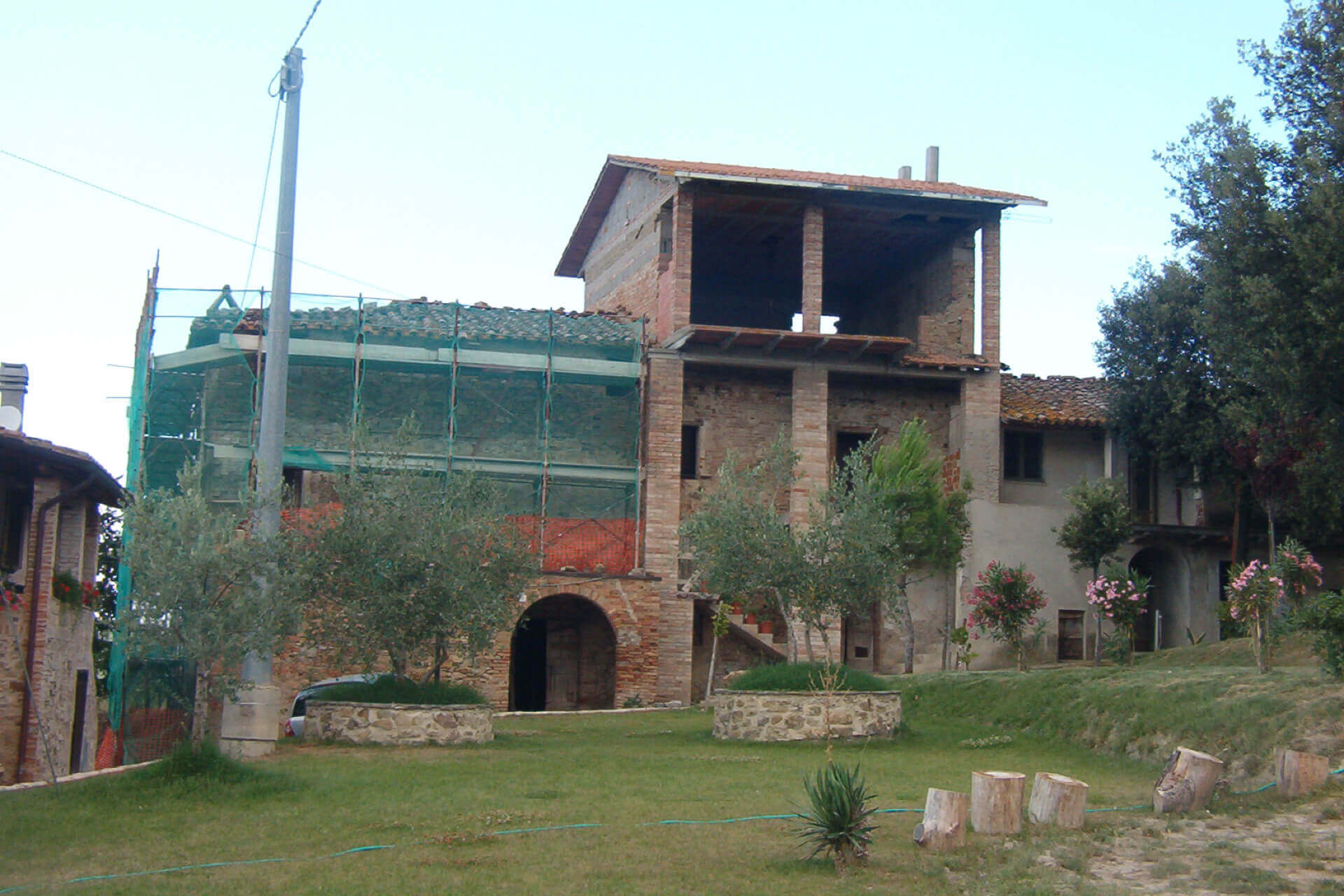The history of Castello Monticelli
Castello Monticelli is composed of 8 listed buildings located on top of a hill, 3 of which are military towers with stone walls of up to 1,60 meters thickness. These 3 towers date back to the end of the 6th century AD and they were part of a large fortress built by the Eastern Roman Empire in 593-5 to defend the city of Perugia and the Byzantine Corridor form the Longobards. The latter are a Scadinavian-Northern German tribe which invaded Italy in 568 and occupied within a short time 80% of the country. The Byzantine corridor was a narrow strip of land linking Rome to Ravenna which the Byzantines managed to keep under their control from 570 to 774.
Castello Monticelli was built by the Eastern Roman Empire 40 meters from the border with the Longobards on the top of a lovely and green hill with a beautiful 360 degees view all around. One sees at a 15 km. distance the Etruscan city of Perugia, now the capital of Umbria, at a 30 km distance Monte Subasio, the mountain behind Assisi, the religious capital of Italy and at a distance of 60 km. Monte Amiata, the highest mountain of Southern Tuscany. At least other 15 medieval hamlets and listed buildings are also visible.
When in 774 Charles the Great defeated the Longobards, the fortress of Monticelli lost its military function and it became not immediately a Benedictine monastery. In about 1470 it was bought by a family of counts and transformed into their private summer and hunting resdence. The buildings of Castello Monticelli could last for so long because their walls are so thick and solid and because their use was cleverly changed when Italy underwent big military, political or social changes. In the course of its long history Castello Monticelli was also used as a farm (1920-60) and as a prison (WWI and WWII).
The oldest document mentioning Castello Monticelli is a papal bull of the year 1115 issued by Pasquale II (1099-1118). It states that the church of Monticelli belonged to the important and powerful Benedictine Monastery of Saint Pietro in Perugia. Pasquale II also nominated in 1112, well before the discovery of America by Columbus, Henricus bishop of Groenland and Newfoundland, an island of Eastern Canada. Henricus is a Scandinavian and a saint of the Catholic Church.
The church of Saint Pietro in Monticelli must have existed well before 1115, because the Benedictines had taken over the hill and the land around it aboout 150 years before. They commissioned the painter Meo da Siena, a student of Giotto, well known to art-historians to paint two walls of the church.
The name Monticelli has historic origins. The name stems from manuscript n.1423 of the Biblioteca Comunale Augusta of Perugia written in the 18th century by Annibale Mariotti: “its heavenly site that is a small hill in the middle of a large valley (dal suo sito amenissimo che è un piccolo monticello in mezzo a vasta pianura)”. The name “Castello Monticelli” appears also in the 2 Government decrees listing the buildings, thus reminding us that in origin it was a fortress. In Monticelli there is also another sign of its great antiquity. When the Benedictines commissioned the frescoes to Meo da Siena they asked him to include Saint Costanzo among the saints. He was the first bishop of Perugia and a Saint of the Catholic Church. He is said to have been hiding at Monticelli for about 3 weeks in 174 AD during a persecution of the Christians under Emperor Marcus Aurelius. This is reported by Cardinal Ceasar Baronio in his “The Life of Saints” written in the 16th century. If the Benedictines asked the painter to depict also Saint Costanzo, all in all a very minor figure compared to the eight others saints of the frescoes, it means that they remembered that he had been hiding there almost 1150 years before.
The Chapel of Saint Paul and Saint Ubaldo
Beside the towers lies a small chapel which was built before the year 1115. The chapel was originally the apse of a much larger church which no longer exists. The official maps of the tax office of the Papal State dating from 1720-29 show that the church was still standing at that time. The apse was probably saved because of the beautiful frescoes on its walls. A papal bull of 1115 attributes the church to the powerful and rich Benedictine monastery of San Pietro in Perugia.
Inside the chapel there are delicate frescoes painted between 1315 and 1319 by the artist Meo da Siena, a student of Giotto, and the main painter of Umbria between 1290 and 1330. He is well known to the art-historians and there are several of his paintings in the National Gallery of Perugia, in the Steden museum in Frankfurt, in several churches in Umbria and Latium and apparently one is in New York.
The frescoes show Christ on the cross, Our Lady with the Child and 9 saints, all except two in life-size proportions. Below Christ on the cross there is a Madonna with Child, Saint John the Baptist, who announces the coming of Christ, and Saint John the Evangelist, the author of the Apocalypse, who marks the end of time. In Christian religious art the image of Christ is closely related to the sun and the two Saint Johns, one looking forward and the other looking backward, remind us of the great importance of time for everybody’s life and for the rise and fall of empires and civilizations. Some historians of Christian art consider the two Saint Johns as a Christian version of the Roman God Janus who had two faces. All catholic churches named after Saint John are dedicated without exeption to both of them.
The way we were before 1999
The restoration of Castello Monticelli was started on June 1st 1999. It lasted 14 years. Before the restoration the listed buildings were a ruin where for decades it had been impossible to live, except in two apartments. In them one could live only until 1996. The roofs of all the buildings and their pavements were all about to collapse and it was very dangerous to go inside them. In all the property there was no running water, no electricity, no gas, no heating and no bathrooms. Before restoration started there were 240 iron bars trying to prevent the roofs and the pavements from collapsing. Before the restoration Castello Monticelli had also great charm and was very fascinating to observe despite the fact that it was a ruin or maybe just because of it. It had the same fascination that very antique buildings often have when they are about to disappear forever from the face of the earth and when they remind us of the inexorable passage of time. Its charm was therefore very different from the one it has today. The photos below do not reflect well enough what stated above. They are digital photos taken from the family albums.






